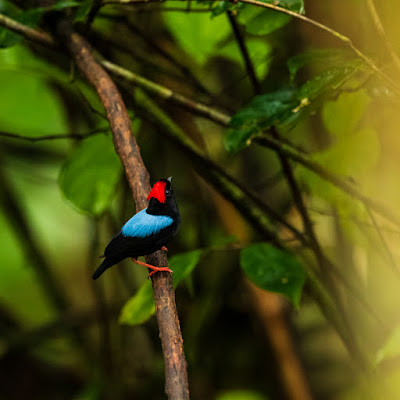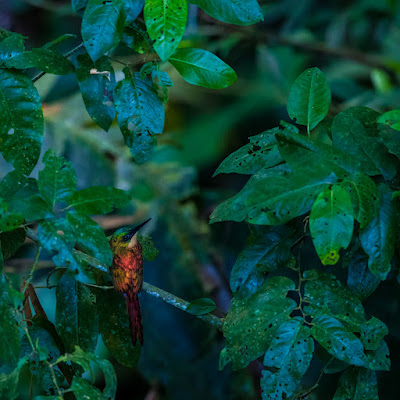Secret Rituals of the Rainforest
Faraaz Abdool returns to Tobago’s Main Ridge Forest Reserve. Birds are everywhere. Who knows what we might find in these easily accessible forests, with a knowledgeable guide? (All photos courtesy Faraaz Abdool)
An
adult male Blue-backed Manakin at the lek.
Squelching through one of the many muddy trails leading into the Main Ridge Forest Reserve, I drew in a sharp, deep breath. The crisp, cool mountain air rushed into my lungs, satisfying my soul on so many levels. The pandemic had brought a months-long separation between me and Tobago’s lush rainforest. Finally, this spell was broken, and I was back.
Blooming side by side, the vivid vermilion flowers of the invasive immortelle almost overshadowed the Olympic torch-like flowers of the native bois flot tree. Both species of trees provided a banquet to countless nectar and fruit seekers. From oropendolas to honeycreepers, the canopy was abuzz with activity. The raucous calls of the Rufous-vented Chachalacas were interspersed with the occasional sharp whistle of one of a few attending Giant Cowbirds. The cowbirds were keeping a keen eye on the Crested Oropendolas. If caught unaware, the large, affable black and yellow oropendolas could be faced with raising a sleek, all-black Giant Cowbird! Female Giant Cowbirds were just waiting on the signal from one of the bull-necked males to fly into one of the pendulous nests belonging to the Crested Oropendola and deposit one of her eggs. Their social structure is complicated and tremendously intertwined with these two species sharing both friendly and hostile interactions.
The
Rufous-breasted Hermit with his distinctive beak. You
don’t need exceptional eyesight to spot the Rufous-tailed Jacamar
Closer to the ground was a different ecosystem altogether, with an entirely separate suite of birds. The iridescent hummingbirds of the canopy were replaced by the subtle brick-red hues of Rufous-breasted Hermits. The hermits are a secretive family of hummingbirds, with a characteristic strongly decurved bill ideally suited for the corollas of heliconias and other flowers of the forest understory. Within the Main Ridge Forest Reserve the Rufous-breasted Hermits aren’t that secretive, and often fly directly toward the observer before darting off into the shadows. Lucky eyes would track the buzzing of wings not to a hermit but to a rich flash of bluish green belonging to a White-tailed Sabrewing.
Further down the trail along a gentle ascent, the shriek of a Golden-olive Woodpecker drew our attention to the source of the sound. Also very vocal were a few Cocoa Woodcreepers – while nowhere near as boldly plumaged as the woodpecker, these cryptic birds possess a loud, far-reaching whistle that betrays their presence. Tobago is home to three species of woodpeckers as well as three species of woodcreepers; one of each species is not found on Trinidad.
Tobago’s forests are the enduring habitats for an eden of birds. Whether it is the rustling of a White-tipped Dove in the undergrowth or a stately Rufous-tailed Jacamar deftly perched on a gnarled vine, large eyes attentive to all movement, the birds do not seem to mind human presence. Even the king-of-the-woods himself, the Trinidad Motmot – although endemic to both Trinidad and Tobago – is much more visible across Tobago than on the island which gives its name.
Deeper into the forest, we come upon our chosen location. It may seem just another hill in the rainforest, covered in the same vegetation, sun filtering to fallen leaves and mossy branches. But this is one of the most important areas for one of Tobago’s iconic birds. It is a classroom for the inexperienced and a dancehall for the seasoned. In ornithological terms, it is a lek.
A lek is an area where male birds perform elaborate courtship rituals to impress females. The females – usually dull-coloured birds – are the ones determining the development of these spectacular plumages and rituals. They are discerning ladies, and male birds would never perform an unrehearsed dance for any female. The routine is honed to perfection over the course of not weeks nor months, but years! Young males pass through a series of plumage iterations before arriving at the distinctive adult plumage which gives rise to their name – Blue-backed Manakin.
Golden-headed Manakin is well-hidden in the dim light of the rainforest White-bearded Manakin
Adult male Blue-backed Manakins are black with a powder blue back and bright scarlet cap. Their dance is complicated and requires a lead or dominant male with three or four subordinate males. Think of them as backup dancers. When the lead male gives the cue, they all fly down to a specific branch where they make unearthly utterances while leapfrogging over each other in a flurry of blue, black, and red in the dim light of the forest understory. This ritual is performed innumerable times with no female in sight just so that when she is present, the performance is impeccable. Once she is in attendance and her interest captured by the dance, the dominant male gives his backup dancers the cue to exit the stage, after which - all going well, of course – he will mate with her.
Manakins are fascinating birds, their unreasonably bright plumage outshone only by ability on the dancefloor. While Tobago has the Blue-backed Manakin, Trinidad is home to two slightly smaller species of manakins. The White-bearded Manakin is black and white with bright orange legs. He needs a clear area just above the forest floor with twigs spaced certain distances apart for the routine. This intriguing behaviour may be enjoyed by visitors to the Asa Wright Nature Centre in Trinidad’s northern range forest.
Another closely guarded secret of Trinidad’s forests is the dance of the tiny Golden-headed Manakin. This bird’s diminutive stature belies its abundance across the island: Golden-headed Manakins can be found wherever there is intact forest. As one of the smaller birds, they have an affinity for the canopy.
These three manakins can be found with relative ease in the forests of Trinidad and Tobago. All that you require is patience and stillness. Familiarity with their song can help, but is not necessary. Even if you don’t find these specific rituals, the forest provides surprises beyond what is needed, encouraging you to come back again and again, with patience and stillness.








